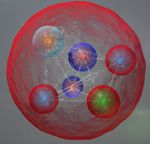Hadron and nuclear physics with electromagnetic probes
Our research uses intense electromagnetic beams to address fundamental questions in physics and astrophysics at distance scales ranging from the quark level, through nuclei to neutron stars. The questions addressed in our research include What is the origin of the mass of visible matter? What is the nature of quark confinement? Do exotic hadrons exist other than the established 3-quark and 2-quark systems? What is the structure and composition of neutron stars? Can a complicated many body quantum-mechanical system such as the nucleus be calculated from scratch using only the strong force. Our group uses the world's leading high intensity electromagnetic beam facilities such as the Thomas Jefferson National Laboratory (JLAB) in the USA and the recently upgraded MAMI-C microtron facility in Germany. The intensities and beam energies achievable at these next generation facilities create exciting and new opportunities to elucidate the properties of strongly interacting matter, from the scale of nuclei down to the scale of their nucleon and quark components.
In achieving our science we lead the development of state of the art detector systems employed at overseas laboratories. We have developed a new fast timing hodoscope which operates near to the beamline with the CLAS12 experiment at Jefferson Laboratory, developed Particle identification systems and nucleon spin polarimeters at MAMI. The resulting expertise in the latest photon detection technologies and readout has led to many spin-offs in medical and applied physics.

Recent research highlights
The d*(2380) in neutron stars - a new degree of freedom? - https://www.sciencedirect.com/science/article/pii/S037026931830248X
First measurement of size and shape of the neutron skin in 208Pb, Physical Review Letters 112, 242502 - https://journals.aps.org/prl/abstract/10.1103/PhysRevLett.112.242502
The skin of a nucleus - Nature Physics 12(2):116-117 - https://www.nature.com/articles/nphys3654
Deuteron photodisintegration by polarized photons in the region of the d*(2380) - https://arxiv.org/abs/1809.09398
People
- Prof Dan Watts
- Dr Mikhail Bashkanov (STFC Rutherford Fellow)
- Dr Nick Zachariou (STFC Rutherford Fellow)
- Dr Dominik Werthmueller (PDRA)
Collaborators
- Thomas Jefferson Laboratory (USA)
- MAMI microtron facility (Germany)
- New Electron-ion collider facility
